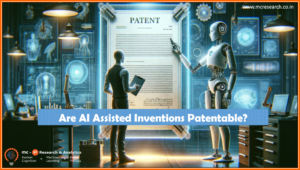Understanding patent law can be challenging because it is a complicated and frequently perplexing area of the law. The doctrine of prosecution history estoppel, which can be applied to restrict a patent’s scope, is one of the more difficult subjects. We’ll go over what prosecution history estoppel is in this blog post and why it’s significant.
HISTORY OF PROSECUTION ESTOPPEL
History of prosecutions estoppel is a legal theory in patent law that restricts a patent application’s ownership rights. When a patent holder drafts a claim it limits the scope of the patent during the patent’s prosecution. Once the patent application is submitted to a patent office, an examiner generally provides their views about the application submitted. These views referred as arguments or in some cases prior art rejections, claim amendments, etc. determine the scope of the patent’s rights. As a result, patent holders should be conscientious in their statements and provide clear and unambiguous information related to the claims they are attempting to make. Ultimately, prosecution history estoppel serves to ensure that patent holders do not gain any undue advantage over competitors through statements made in the patent prosecution process.
WHAT IS INVOLVED IN THE PROSECUTION PROCESS?
The patent prosecution process is the process of filing a patent application with the Patent Office and then working with the Patent Office to attempt to obtain a patent grant from the Patent Office. Prosecution history estoppel, also known as file wrapper estoppel or prosecution disclaimer, is a legal doctrine in patent law that limits the scope of a patent holder’s rights by examining the statements made by the patent holder during the patent prosecution process. Specifically, prosecution history estoppel arises when a patent holder makes a clear and unambiguous statement to the Patent Office during the prosecution of the patent application that narrows the scope of the patent claims. Such statements may include, for example, arguments made to overcome prior art rejections, amendments to more narrowly define claims, and explanations for why certain claim limitations should be included. These statements are then taken into consideration when determining the enforceable scope of the claims of an issued patent.
HOW DOES PROSECUTION HISTORY ESTOPPEL LIMIT PATENT RIGHTS?
Prosecution history estoppel is a legal doctrine in patent law that limits the scope of a patent holder’s rights by examining the statements made by the patent holder during the patent prosecution process. For example, any arguments made to overcome prior art rejections, amendments to claims, and any express relinquishment or disclaimer of claim scope can all potentially be used as evidence that prosecution history estoppel applies and limits a patent holder’s rights as to such matters Meanwhile, prosecution history estoppel serves to limit the scope of a patent holder’s rights, by examining the patent holder’s statements during the patent prosecution process. These statements may include arguments made to overcome prior art rejections, amendments to claims, and any express relinquishment or disclaimer of claim scope. Thus, any of these statements can be used as evidence that prosecution history estoppel applies and limits a patent holder’s rights.
RELEVANT CASE LAW – Festo Corp. v. Shoketsu Kinzoku Kogyo Kabushiki Co. - 535 U.S. 722, 122 S. Ct. 1831 (2002)
About the case
Background and Patents:
Festo Corporation, the petitioner, held patents for a rodless cylinder with a magnet-operated piston used in the transfer process. The initial patent application was modified after being rejected by the examiner, and the second patent’s application was revised during re-examination. Both patents required the inclusion of two sealing rings as a necessary feature for the inventions.
Festo’s Patent Application Process: Festo’s initial patent application was declined due to unclear operation procedures and impermissible claims. In response, the application was modified to address the examiner’s concerns. Similarly, the second patent’s application underwent a re-examination process to ensure compliance with patent requirements.
SMC’s Entry into the Market: While Festo was selling their rodless cylinder, SMC entered the market as a competitor with their own version of the device. However, SMC’s product had notable differences, including the use of a single sealing ring and a different material for the outer sleeve.
Festo’s Claim of Patent Infringement: Festo alleged that SMC’s device infringed on their patents using the doctrine of equivalents. Despite not meeting all the specific parameters outlined in Festo’s patents, Festo argued that SMC’s device was sufficiently similar to constitute infringement.
The Doctrine of Equivalents: The doctrine of equivalents allows for a finding of patent infringement even if minor alterations were made to the patented invention. It states that certain modifications or substitutions, not explicitly mentioned in the patent claims, can still be considered equivalent and infringing.
Lawsuit and District Court’s Ruling: Festo filed a lawsuit against SMC in the US District Court for the Massachusetts District. The court granted partial summary judgment before the trial, ruling that SMC had committed patent infringement under the doctrine of equivalents. The remaining issues were presented to a jury for deliberation.
Jury Verdict and Damages Awarded: The jury determined that SMC had infringed on another patent claim and awarded damages accordingly. Festo successfully proved infringement for some aspects of their patents through the trial process.
Festo’s Inability to Claim Infringement: Festo encountered a hurdle in claiming infringement under the doctrine of equivalents due to prosecution history estoppel. This legal principle prevents patentees from asserting equivalence for any element that was amended during the patent application process.
Reversal of the District Court’s Judgment by the Court of Appeals: The Court of Appeals reversed the District Court’s judgment on Festo’s infringement claim. They found that Festo was precluded from asserting the doctrine of equivalents due to prosecution history estoppel, which limited their ability to claim equivalence for any amended element.
Problem Statement
Would Festo be prevented from claiming infringement using the doctrine of equivalents due to prosecution history estoppel, even when a patent element was modified?
FinalSay on the case
The verdict passed by the The United States Court Of Appeals For The Federal Circuit was that the prosecution history estoppel cannot prohibit a patentee from accusing infringement against an equivalent of the narrowed element in a patent prosecution where the claim has been reduced following the rejection of the initial patent application. In determining whether an amendment made to comply with § 112 of the Patent Act is merely a superficial modification, the Court has established that it must not in any way limit the patent’s scope or create an estoppel. Conversely, should the amendment be obligatory and have the effect of restricting the patent’s coverage, even if it is solely for the purposes of a clearer definition, it may trigger an estoppel. In these cases, the patent holder was required to prove that any amendments made were not intended to create an estoppel. Additionally, they had to demonstrate that the changes did not relinquish the corresponding equivalent in question. This burden of proof was established by the Court’s ruling.
The Court observed that amendments made in the present case were aimed at enhancing the patentability of the subject matter. However, it remained unclear as to the extent of territorial surrender that resulted from these amendments. After evaluating the situation, the Court determined that while estoppel did not entirely prevent further action, Festo must still demonstrate that their adjustments did not forfeit the corresponding alternatives. These concerns were returned to the lower court for additional review.
The purpose of this estoppel is to ensure that a patent holder cannot gain an unfair advantage by later attempting to assert broader rights than those originally disclosed in prosecution of their patent application. Practitioners must thus be mindful of the potential impact of any statements made during prosecution and the applicability of prosecution history estoppel in any given case.
CONCLUSION
Overall, prosecution history estoppel is an important tool to understand when it comes to patent law. It is used to limit the scope of a patent and can be used to invalidate claims in a patent if they are not substantially identical to claims that were previously rejected by the patent examiner. Understanding what prosecution history estoppel is and how it works can help ensure that a patent is as ironclad as possible.
Need to check the prosecution history estoppel in your patent licensing or infringement case? Look no further than MCRPL. Our reliable technology quickly provides accurate results to ensure you get the best possible outcome for your case. Our powerful platform provides access to up-to-date prosecution history estoppel information to ensure accuracy and efficiency in your work. Try our services today for a smooth and successful legal experience!





